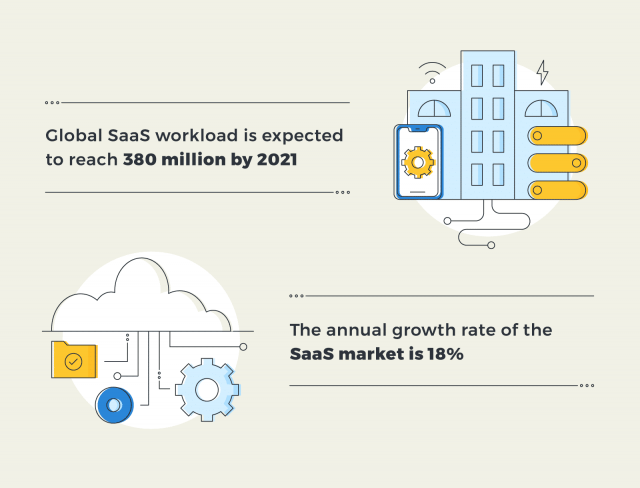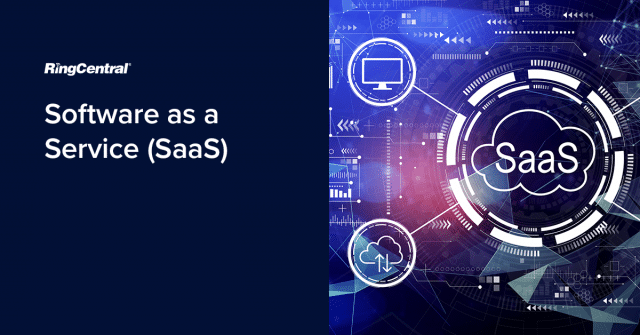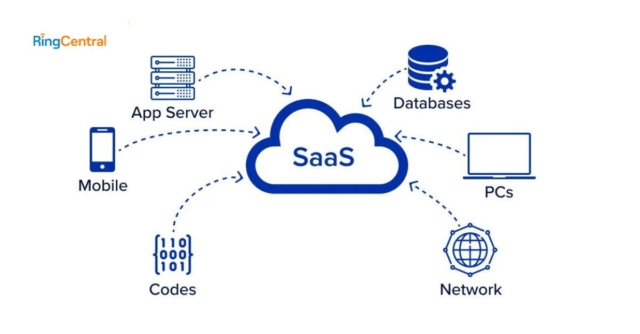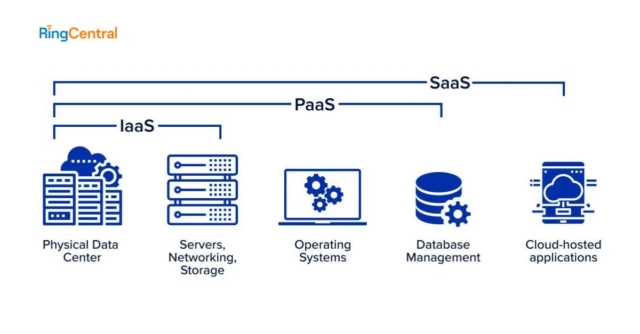Software as a Service, or SaaS for short, is now being used by organisations en masse. SaaS forms one of three major cloud computing categories (SaaS, PaaS and IaaS) or models for delivering solutions to end-users.
In short, it is a software distribution model that allows a remote service provider to host business applications for customers over the internet.
In this article, we will differentiate between the three principal cloud computing models and discuss the benefits of SaaS in business today.
What is SaaS (Software as a Service)?
SaaS meaning
Software as a Service (SaaS) is one of three popular cloud computing models. But let’s delve a bit deeper. With the SaaS model, a third-party remote provider hosts applications for customers over the internet.
SaaS providers host cloud-based software solution applications. This could be any application from email to office tools. Organisations rent these applications on a pay-as-you-go basis for their users.
Instead of investing in complex IT infrastructure in-house, all underlying infrastructure, middleware, software and data is stored in an external data centre. It is the application service provider that manages infrastructure functionality, availability and data security.
By handing over technical responsibility to an external agent, businesses that mobilise SaaS can get up and run faster. That’s great for cost savings and bypasses the heavy expenditure required when scaling up IT infrastructure in-house.
How does SaaS work?
SaaS works as an on-demand computing software delivery model. It is similar to application service provision (ASP). With ASP, external providers host customer software and deliver it via online user interfaces.
SaaS providers give customers network access to applications. Customer data can be stored locally or in the cloud. SaaS can also be integrated with other existing software by using an API.
IT professionals, CIOs and business users from startups to multinationals use SaaS applications to support standard technology setups such as:
- Sales management
- Customer relationship management (CRM)
- Financial management
- Human resource management (HRM)
- Collaboration
- Billing
What are the differences between SaaS, Paas and IaaS?
We already mentioned the three types of cloud computing – Iaas, PaaS and SaaS. These three service models are booming as more and more businesses worldwide move online to the cloud. But what is the difference, and which one is the best option for your organisation?
SaaS
Software as a Service now accounts for 24% of all enterprise IT workloads. SaaS platforms provide software accessibility to users, without installation, over the internet, in return for a subscription fee often based on a monthly pricing model.
Everything is available via an online account and accessible from any device with an internet connection. Different members of an organisation can access variations of the software per their relevant access status.
In other words, businesses no longer need IT specialists, to manage multiple computing software instances. With SaaS, everything happens on the cloud and is managed and maintained by your external service provider for a fixed cost, improving user experience.
Basic software can be set up in a matter of hours, but the service is scalable to larger, enterprise-level business needs as well. SaaS is ideal for businesses seeking minimal IT input and the peace of mind that a professional team is available for support.

PaaS
Platform as a Service is now the most popular cloud computing model. It dominates approximately 32% of the market share and is expected to keep growing. PaaS vendors supply hardware and software tools over the internet.
Businesses and organisations use these online tools to develop their own custom applications. As such, a lot of PaaS users are developers. Developers save time and money by using PaaS. They don’t have to write masses of code from scratch.
As a result, PaaS is popular with businesses that need unique, functioning applications without the time and money traditionally associated with application programming. PaaS is an easy to use, accessible, and scalable service built upon virtualisation technology.
You don’t need to have extensive technical knowledge to use PaaS tools. That means developers can focus on creativity and brand identity over software management. All clients need to do is upload and monitor their applications.
IaaS
Infrastructure as a Service now holds 12% of the market share. IaaS tools offer organisations cloud-based storage, networking, and virtualisation solutions. This is a great alternative to expensive and labour exhaustive on-premises infrastructure.
Instead of investing heavily in specialist IT infrastructure and workforce, businesses can pay as they go—again, usually every month—and scale up accordingly. IaaS users can access and monitor their platforms without requiring specialist help.
IaaS offers businesses to control, savings, scalability, and ongoing support, making it a great way to future proof operations.
What are the differences between SaaS and on-premises?
On-premises IT systems used to be the norm, but the cloud is fast becoming the new normal. Internet-based operations can not be used for most business and organisational processes. The principal difference lies in location.
On-premises software is IT infrastructure installed on site. That means in the same building as the business operating it. In contrast, SaaS and other cloud-based services operate online. All the hardware and software is available via a third-party provider over the internet.
As such, businesses no longer need to commit to expensive, on-site IT infrastructures and experts. Instead, they can pay a third-party provider for all the necessary services and applications they need, from storage to networking and virtualisation.
In short, SaaS and other cloud-based services are cheaper, easier to manage, and much more accessible than traditional on-premises IT infrastructures.

What are examples of SaaS?
There are plenty of benefits when it comes to SaaS, but how about some real-world examples? Chances are, you’ve already come across SaaS applications without even knowing it.
SaaS for personal use
Many web-based email services are SaaS platforms. Users log in via the internet, but the software is located externally. Because SaaS platforms store data online, the user can then access their database of messages from any web browser, anywhere.
SaaS for organisational use
Organisations of all sizes use SaaS. Whether you’re a small business owner or a C-level executive, you’ll have used a solution delivered via the model. Some rent productivity apps like email, calendar and collaboration tools. Others require more sophisticated applications for their business needs. Examples of these apps include:
- Customer relationship management (CRM)
- Enterprise resource planning (ERP)
- Document management
- Billing or payroll processing
- Sales management
- Human resources management (HRM)
- Financial management
- Database management
- Content management
What are the advantages of SaaS?
SaaS boasts major advantages over in-house infrastructure. Amongst other things, SaaS reduces labour-intensive data management, as well as financial pressures and bureaucratic inconveniences. But the main benefits of mobilising SaaS in business include:
Flexible payments
SaaS means businesses no longer have to buy and install expensive, permanent IT infrastructure. Instead, customers subscribe to a SaaS package and pay monthly according to usage. By using SaaS, businesses have more control over their expenses. Expenses are more predictable and can be terminated at any time if necessary.
Scalability and integration
SaaS and other cloud services are super scalable. Customers are free to alter their SaaS plan according to need and demand. They can choose to access more or fewer features as necessary.
Mobilise
SaaS makes it easy to mobilise workforces. SaaS apps can be accessed from any device. Apps do not need to be developed for specific devices, and workforces don’t need to be specialised. All security and IT issues are managed as part of your agreement with the provider.
Access from anywhere
Because SaaS stores data in the cloud, users can access information from anywhere. That’s great news for mobility and remote communications. Any internet-connected computer, mobile iOS, or Android device will have access to SaaS applications. That means data is always backed up to avoid data losses when devices fail.
Easy to use
SaaS tools are easy to use. You do not need to be an IT professional to get the best out of such tools, which means businesses can channel their energies into the things that matter to them. Because users don’t need to download complicated software, previously inaccessible enterprise applications are easily deployed.

What are the disadvantages of SaaS?
Despite glowing reviews, SaaS can pose issues for its users. Let’s take a look at some common disadvantages.
Lack of control
SaaS convenience comes at the cost of control. Businesses rely on external service providers to distribute, manage and maintain software.
Security and data
Your company data will be stored in the cloud. That means placing trust in your external service provider to treat sensitive data appropriately.
Limited range of applications
You are limited to the tools and applications offered by your provider. Most providers offer a good range of applications, but this convenience comes at the cost of total customisation.
Connectivity requirements
SaaS providers sometimes experience service disruption. That means unwanted and unexpected changes to the usual service experience. This could potentially incur a security breach, so it’s important to have a service level agreement (SLA) in place.
Top SaaS providers
It’s important to do some research before picking a SaaS company. Let’s take a look at some top providers out there today.
- Salesforce: launched the initial CRM concept model and has now expanded to incorporate platform development, marketing, analytics and social networking.
- Microsoft: moved the Windows and Office suite to the cloud to produce Office 365. Microsoft also offers dynamic CRM, collaboration tools and SQL server databases. Microsoft Azure offers cross-platform services for building scalable apps.
- Box: Box originally came about as a cloud storage provider. They have now expanded with file collaboration and editing services.
- Amazon Web Services SaaS: Amazon offers platforms for custom building SaaS apps and other third-party SaaS products.
- Oracle: Oracle Corporation’s SaaS offering includes cloud-based servers, storage, network and applications via a global network of data centres – or data centres, depending on where they are.
- SAP: Enterprise software for business operations management and customer relations.
- MacStadium / MacOs: Enterprise-class cloud solutions for Mac and iOS app development.
How RingCentral supports SaaS solutions
RingCentral supports SaaS solutions by providing cloud-based telecommunications solutions for modern businesses. These cloud-based phone systems are hosted and maintained in the provider’s data centre and delivered via an internet connection.
These phone systems have the same routing and management features as a traditional PBX but use VoIP to facilitate calls over the internet. Like most SaaS solutions, cloud-based telecommunications are cheaper and subscription-based, reducing overall infrastructure costs for businesses on the ground.
Originally published Dec 14, 2020, updated Feb 26, 2023




